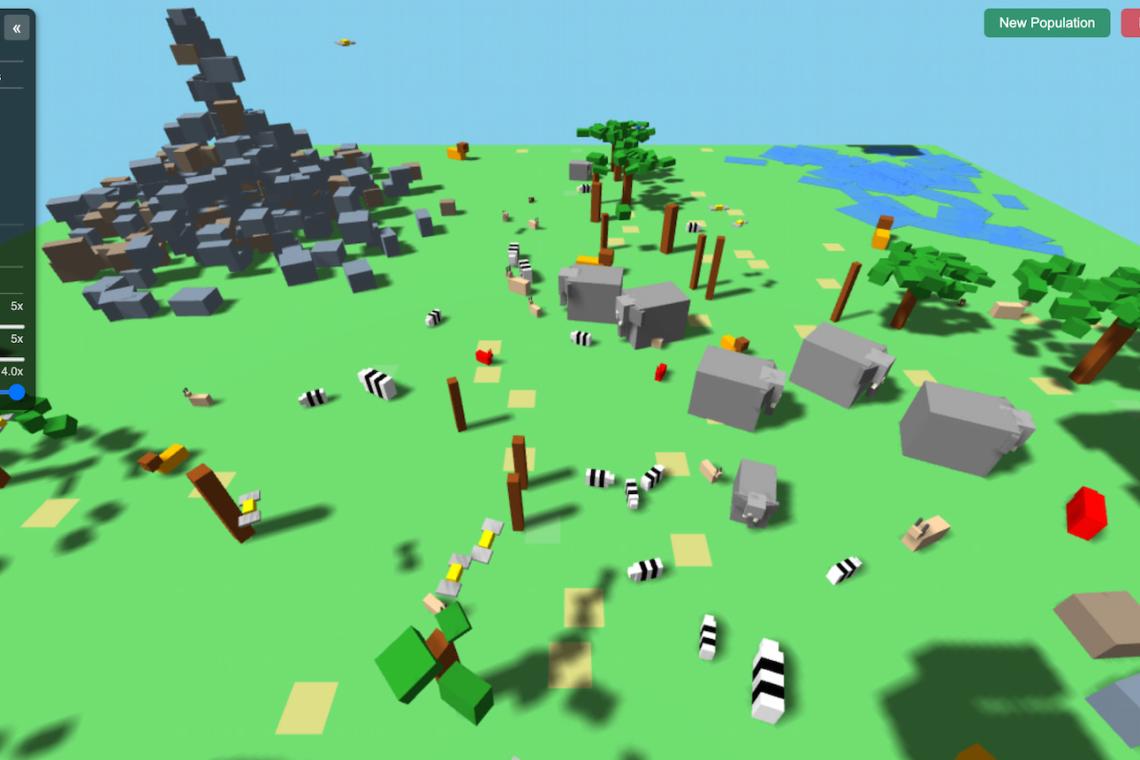Welcome to the Ecosystem Safari
Get started right away by playing the game or joining our players' forum.
Find out more
Have you ever wondered how a real savanna ecosystem works? The delicate balance between predator and prey, the constant search for food and water, the impact of having just the right number of animals for the available resources? It’s a complex dance, and one that’s fascinating to observe.
Here at Conservation Mag, we've been working on a little project to bring some of these dynamics to life: the Ecosystem Simulation Safari. It's a free, interactive tool designed as a fun way for kids (and curious adults!) to learn about ecology, biodiversity, and conservation right from their computer.
What is the Ecosystem Simulation Safari?
Think of it as your own mini digital savanna. Using simple controls, you can:
- Set the Stage: Decide the starting populations for iconic African animals like majestic elephants, proud lions (like Simba or Mufasa!), stripey zebra, graceful antelope, maybe even a warthog (Pumbaa, anyone?), and colourful birds. You also choose the initial number of trees, a vital resource.
- Watch Life Unfold: Hit "Start" and observe the blocky animals navigate their world in 3D. They'll wander, seek water, graze on patches of grass, interact with trees (elephants might even eat the leaves!), form herds, mate, and, yes, predators will hunt.
- Experiment and Learn: Use the dashboard sliders to control factors like how often herbivores and predators reproduce, or how successful the lions are in their hunts. See how changing one element affects the entire system.
Why Simulate an Ecosystem?
It's one thing to read about food webs and habitat loss, but seeing it happen, even in a simulation, offers a different kind of understanding. The goal isn't perfect realism, but to illustrate key ecological concepts:
- Interdependence: See firsthand how populations affect each other. Too many zebras might lead to overgrazing, impacting all herbivores. Too few lions might let herbivore numbers explode unsustainably.
- Resource Limits: Watch how the number of trees (providing leaves for elephants) and grazing patches influence the survival and success of different species.
- The Domino Effect: Discover how removing one piece – like a specific prey animal going extinct within the simulation – can trigger wider "ECOSYSTEM FAILURE".
Connecting the Digital Savanna to Our World
While playing with the simulator, I can't help but reflect on the real-world parallels. This simple tool highlights the fragility we see in actual ecosystems across the globe.
We humans are constantly adjusting the "sliders" on our planet. Land use changes – clearing forests for farming or building cities – directly reduce the available habitat for countless species, just like removing trees or grazing land in the simulation impacts the digital animals. Our food choices also play a huge role, influencing demand for resources and impacting everything from fish stocks (like the sharks I encountered in Sekinchan ) to land cleared for livestock. We are, effectively, borrowing resources from future generations and other species.
Join the Player Community!
Got a high score? Did your ecosystem collapse and you're not sure why? We've created a brand new forum just for our safari players!
It's the official hub to share screenshots, get your "Safari Champion" badge, and chat with other players and our team of conservation experts.
A Learning Tool for Kids and Families
This simulation is particularly aimed at primary school-aged children with an interest in animals, safari adventures, and conservation. It provides a safe and engaging space to:
- Learn about different savanna animals and their roles.
- Understand basic ecological concepts like food chains and population dynamics.
- Think critically about balance in nature and the impact of change.
- Spark conversations about real-world conservation challenges.
It's a great resource for parents looking for educational screen time or teachers wanting an interactive element for lessons on biology, ecology, or environmental science.
How to Master Your Ecosystem (A Mini-Guide)
Having trouble keeping your ecosystem alive? It's harder than it looks! The game is all about balance, just like in the real world. Here are a few tips to help you survive longer:
1. The Predator Problem
Did all your lions starve? Or did they eat all the zebras and then starve? This is a classic "predator-prey cycle." If you have too many predators, they'll wipe out their food source. Too few, and the herbivores (zebras, antelope) will overpopulate and eat all the grass.
Tip: Start with a low number of lions. It's always easier to add more predators later than to recover a prey population that has crashed!
2. The Elephant in the Room
In the real world, elephants are a "keystone species." They have a huge impact on their environment. In the game, you'll see this firsthand: elephants are the only animal that eats the leaves from trees. If you add too many, they will quickly destroy all the trees, leading to a "resource collapse."
Tip: Elephants are a 'hard mode' animal. Try to get a stable ecosystem of just predators and smaller prey first. Then, add one or two elephants and see how your system handles the new pressure.
3. The Herbivore Explosion
It's tempting to fill your savanna with dozens of zebras and antelope. But without a predator (like lions) to keep their numbers in check, the herbivore population will explode. They will quickly eat all the available grass, and the entire population will starve to death.
Tip: Every ecosystem needs a check and balance. Predators are not "evil"—they are a crucial part of a healthy, stable system. Always make sure you have predators to manage your prey populations.
Give it a Go!
Why not head over and try the Ecosystem Simulation Safari for yourself? Set up your savanna, observe the interactions, and see if you can create a balanced, thriving ecosystem. It’s a small window into a complex world, and hopefully, a fun way to learn about the importance of biodiversity and conservation.


